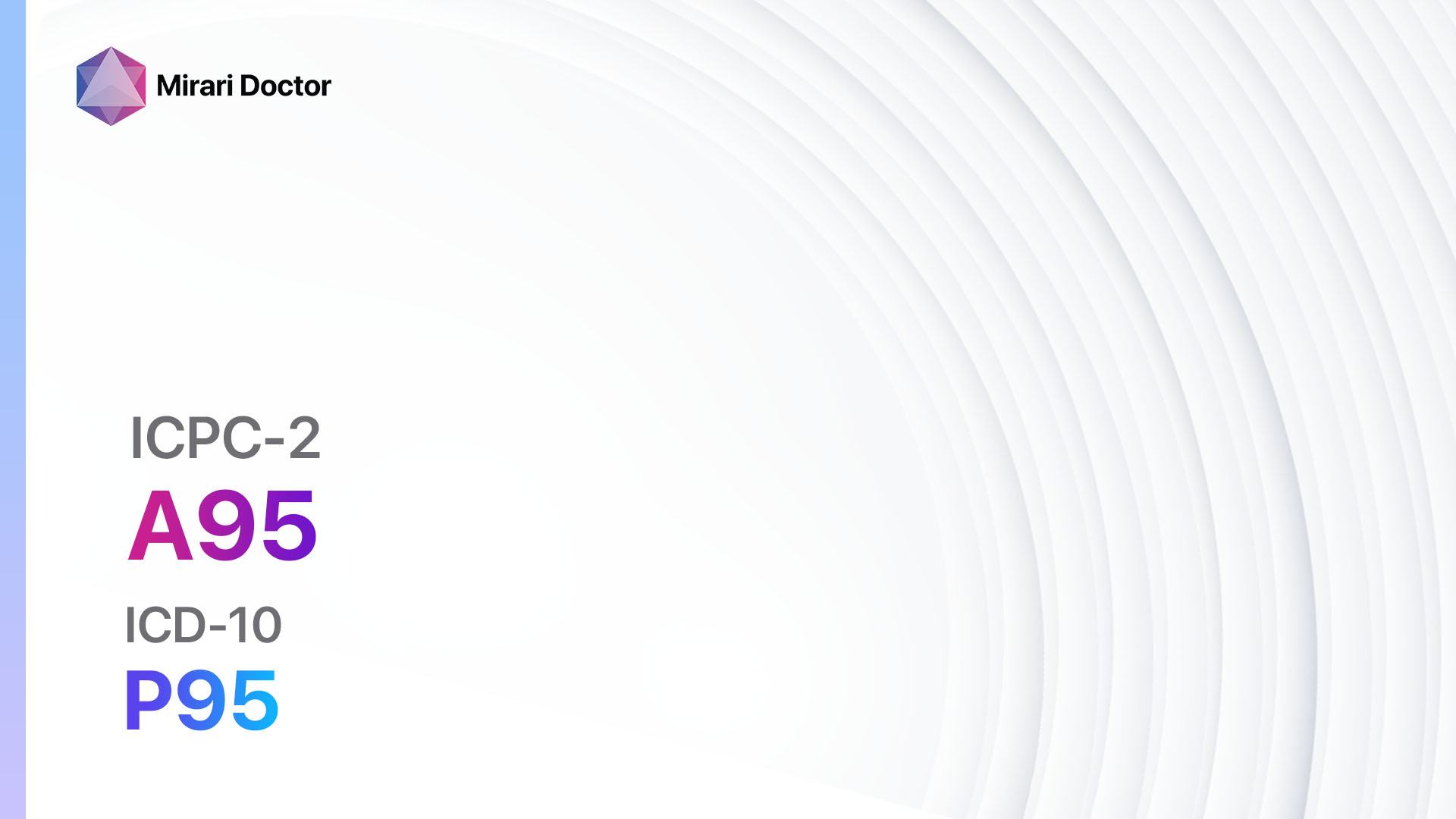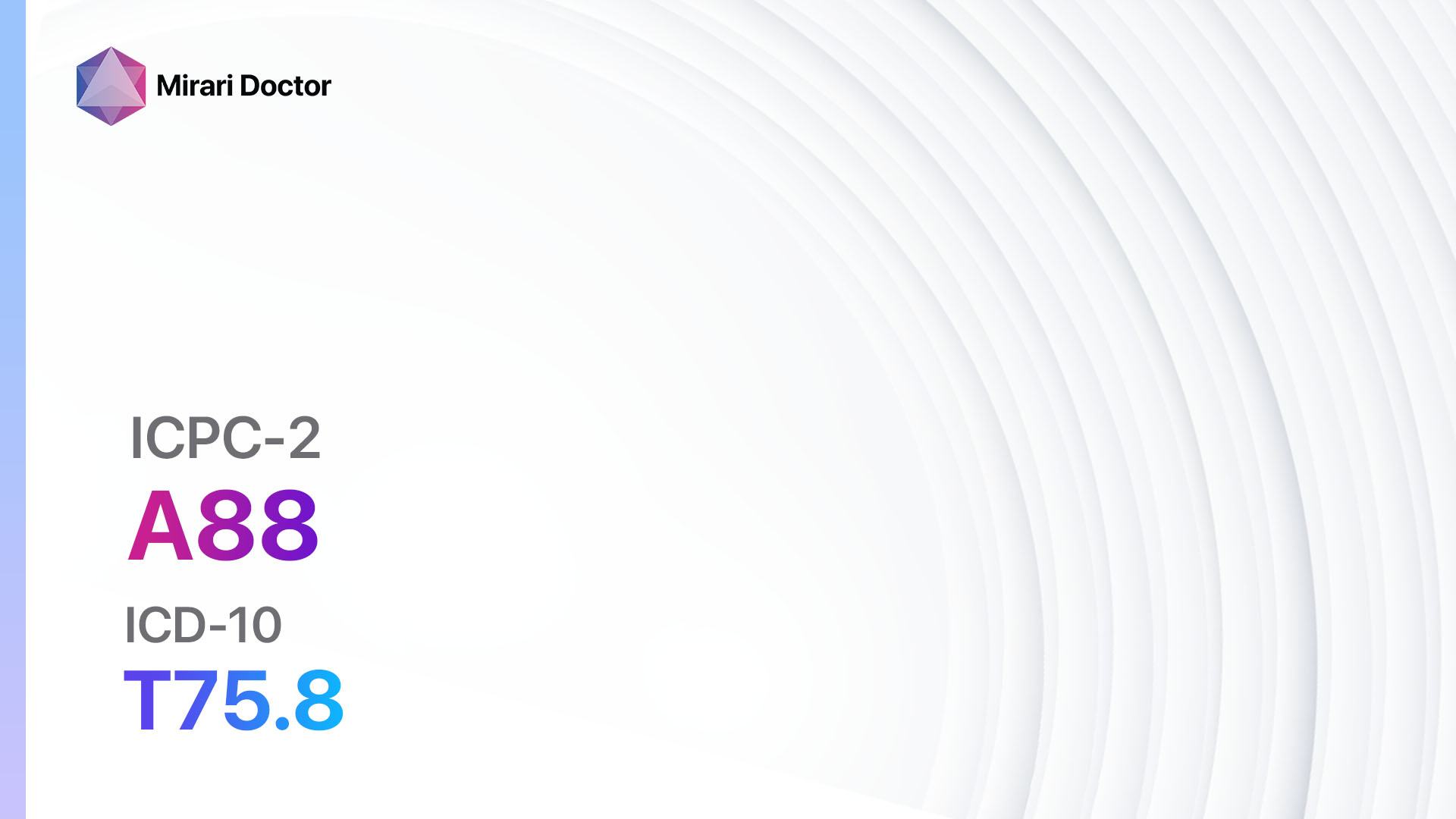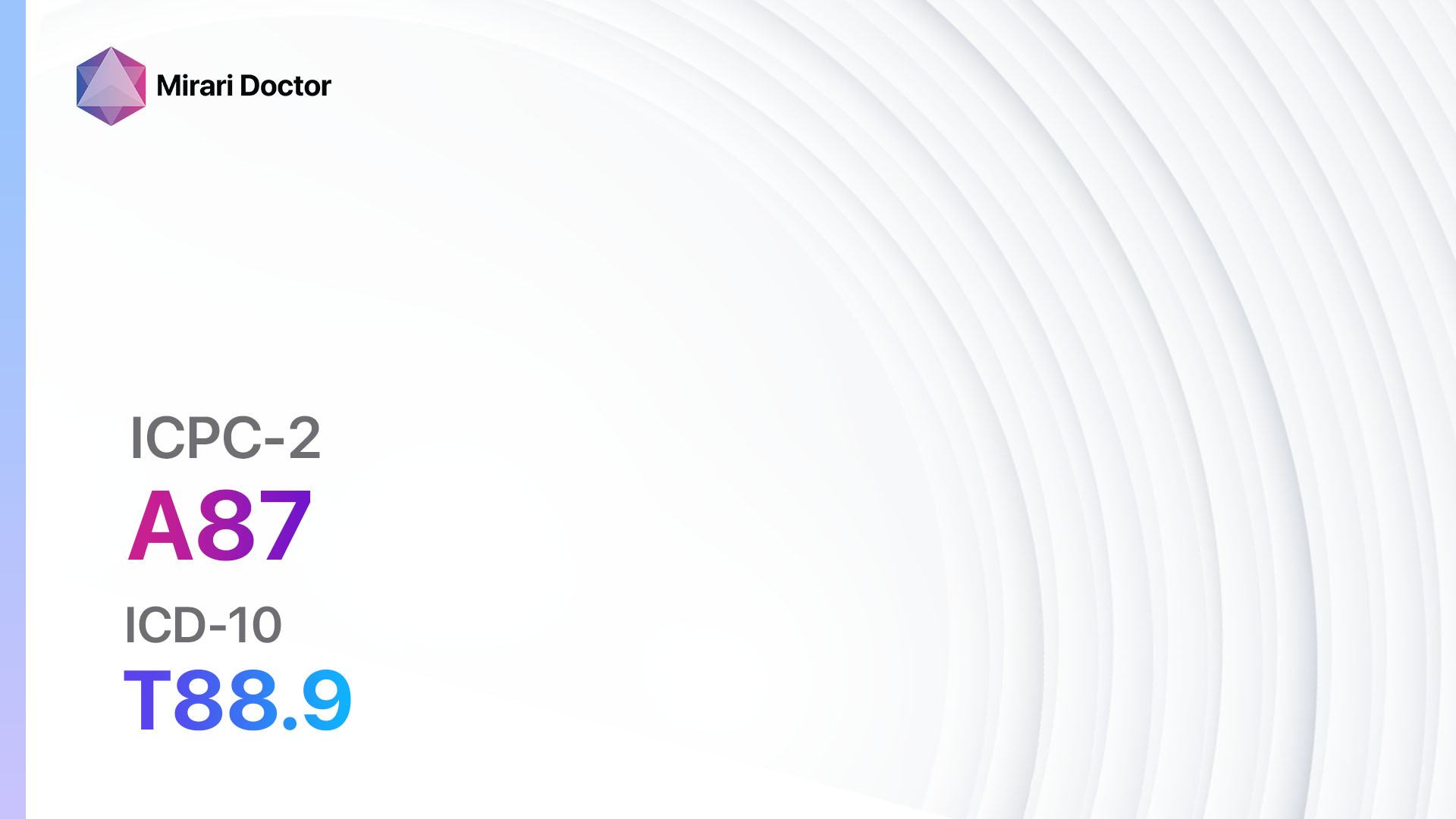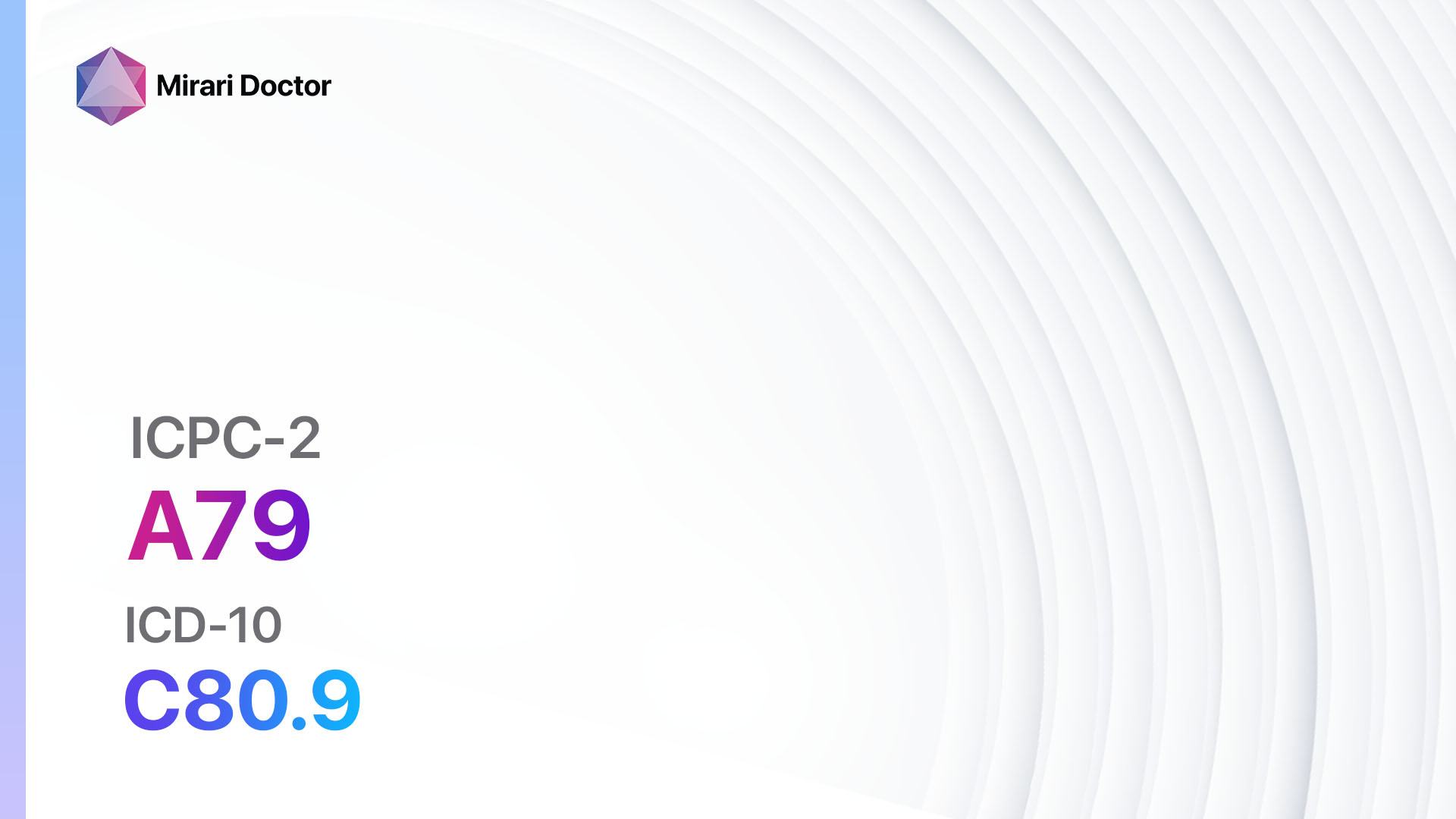
Introduction
Viral exanthem other refers to a rash or skin eruption caused by a viral infection[1]. It is characterized by the presence of a rash that may be accompanied by other symptoms such as fever, headache, and body aches[2]. The aim of this guide is to provide healthcare professionals with a comprehensive overview of the diagnosis and management of viral exanthem other.
Codes
- ICPC-2 Code: A76 Viral exanthem other
- ICD-10 Code: B09 Unspecified viral infection characterized by skin and mucous membrane lesions
Symptoms
- Rash: The primary symptom of viral exanthem other is the presence of a rash on the skin. The rash may appear as red spots, bumps, or blisters and can be itchy or painful[3].
- Fever: Many individuals with viral exanthem other may experience fever, which is often low-grade[4].
- Headache: Headaches are common in viral exanthem other and may be accompanied by other symptoms such as fatigue and body aches[5].
- Sore throat: Some individuals may experience a sore throat, which can be mild or severe[6].
- Fatigue: Fatigue and general malaise are common symptoms of viral exanthem other[7].
Causes
- Viral infection: Viral exanthem other is caused by various viral infections, including enteroviruses, adenoviruses, and parvovirus B19[8]
- Contact with infected individuals: The virus can be transmitted through direct contact with an infected individual or through respiratory droplets[9].
Diagnostic Steps
Medical History
- Obtain a detailed medical history, including information about recent illnesses, exposure to individuals with viral infections, and the onset and progression of symptoms[10].
- Ask about any other symptoms the patient may be experiencing, such as fever, headache, or sore throat.
- Inquire about any recent travel or exposure to individuals with known viral infections.
Physical Examination
- Perform a thorough physical examination, paying particular attention to the skin. Look for the presence of a rash, its distribution, and any associated symptoms such as itching or pain.
- Check for other signs of viral infection, such as fever, enlarged lymph nodes, or sore throat.
Laboratory Tests
- Blood tests: A complete blood count (CBC) may be performed to assess for any abnormalities, such as an elevated white blood cell count or presence of specific viral markers.
- Viral serology: Serological tests can help identify the specific viral infection causing the exanthem. These tests detect antibodies produced by the immune system in response to the virus.
- Polymerase chain reaction (PCR): PCR tests can detect the presence of viral genetic material in the blood or other body fluids, providing a more accurate diagnosis.
Diagnostic Imaging
- Diagnostic imaging is not typically necessary for the diagnosis of viral exanthem other. However, in certain cases, imaging modalities such as ultrasound or CT scans may be used to evaluate specific complications or organ involvement.
Other Tests
- In some cases, a skin biopsy may be performed to rule out other potential causes of the rash or to confirm the diagnosis of viral exanthem other.
Follow-up and Patient Education
- Provide appropriate follow-up care based on the severity of symptoms and the patient’s overall condition.
- Educate the patient about the self-limiting nature of viral exanthem other and the importance of supportive care measures, such as rest, hydration, and over-the-counter pain relievers.
Possible Interventions
Traditional Interventions
Medications:
Top 5 drugs for Viral exanthem other:
- Acetaminophen (e.g., Tylenol):
- Cost: $5-$10 for a bottle of 100 tablets.
- Contraindications: Hypersensitivity to acetaminophen.
- Side effects: Rare, but can include allergic reactions or liver damage with high doses.
- Severe side effects: Liver failure with overdose.
- Drug interactions: None significant.
- Warning: Do not exceed recommended dosage.
- Antihistamines (e.g., Diphenhydramine, Loratadine):
- Cost: $5-$15 for a bottle of 30 tablets.
- Contraindications: Hypersensitivity to antihistamines.
- Side effects: Drowsiness, dry mouth.
- Severe side effects: Rare, but can include allergic reactions or difficulty breathing.
- Drug interactions: Sedatives, alcohol.
- Warning: May cause drowsiness, avoid driving or operating machinery.
- Topical corticosteroids (e.g., Hydrocortisone cream):
- Cost: $5-$15 for a tube of cream.
- Contraindications: Hypersensitivity to corticosteroids.
- Side effects: Skin thinning, irritation.
- Severe side effects: Rare, but can include allergic reactions or systemic absorption with prolonged use.
- Drug interactions: None significant.
- Warning: Use sparingly and for short durations.
- Antiviral medications (e.g., Acyclovir, Valacyclovir):
- Cost: $20-$100 for a course of treatment.
- Contraindications: Hypersensitivity to antiviral medications.
- Side effects: Nausea, headache.
- Severe side effects: Rare, but can include allergic reactions or kidney damage.
- Drug interactions: None significant.
- Warning: Start treatment early for best results.
- Pain relievers (e.g., Ibuprofen, Naproxen):
- Cost: $5-$15 for a bottle of 100 tablets.
- Contraindications: Hypersensitivity to nonsteroidal anti-inflammatory drugs (NSAIDs).
- Side effects: Upset stomach, increased risk of bleeding.
- Severe side effects: Rare, but can include gastrointestinal bleeding or kidney damage.
- Drug interactions: Other NSAIDs, blood thinners.
- Warning: Take with food to minimize stomach upset.
Alternative Drugs:
- Antiviral herbs (e.g., Echinacea, Elderberry): These herbal supplements may have antiviral properties and can be used as an alternative or adjunct to antiviral medications. Cost: Varies depending on the specific supplement.
- Calamine lotion: Provides relief from itching and can be applied topically to the rash. Cost: $5-$10 for a bottle of lotion.
- Zinc oxide cream: Can help soothe and protect the skin. Cost: $5-$10 for a tube of cream.
Surgical Procedures:
- Surgical procedures are not typically indicated for the treatment of viral exanthem other.
Alternative Interventions
- Cool compresses: Applying cool compresses to the affected areas can help relieve itching and discomfort. Cost: Minimal.
- Oatmeal baths: Adding colloidal oatmeal to bathwater can help soothe the skin and reduce itching. Cost: $5-$10 for a box of oatmeal.
- Aloe vera gel: Applying aloe vera gel to the rash can help reduce inflammation and promote healing. Cost: $5-$10 for a bottle of gel.
- Herbal remedies: Certain herbal remedies, such as chamomile or calendula, may have anti-inflammatory and soothing properties. Cost: Varies depending on the specific remedy.
- Probiotics: Probiotic supplements may help support the immune system and reduce the severity and duration of viral infections. Cost: $10-$30 for a bottle of probiotics.
Lifestyle Interventions
- Rest: Adequate rest is essential for the body to recover from a viral infection. Cost: None.
- Hydration: Drinking plenty of fluids helps maintain hydration and supports the immune system. Cost: Minimal.
- Avoidance of triggers: Identify and avoid any triggers that may exacerbate symptoms, such as certain foods or environmental allergens. Cost: None.
- Healthy diet: Consuming a balanced diet rich in fruits, vegetables, and lean proteins can help support the immune system. Cost: Varies depending on food choices.
- Stress management: Engaging in stress-reducing activities, such as meditation or yoga, can help support overall well-being. Cost: Varies depending on chosen activities.
It is important to note that the cost ranges provided are approximate and may vary depending on the location and availability of the interventions.
Mirari Cold Plasma Alternative Intervention
Understanding Mirari Cold Plasma
- Safe and Non-Invasive Treatment: Mirari Cold Plasma is a safe and non-invasive treatment option for various skin conditions. It does not require incisions, minimizing the risk of scarring, bleeding, or tissue damage.
- Efficient Extraction of Foreign Bodies: Mirari Cold Plasma facilitates the removal of foreign bodies from the skin by degrading and dissociating organic matter, allowing easier access and extraction.
- Pain Reduction and Comfort: Mirari Cold Plasma has a local analgesic effect, providing pain relief during the treatment, making it more comfortable for the patient.
- Reduced Risk of Infection: Mirari Cold Plasma has antimicrobial properties, effectively killing bacteria and reducing the risk of infection.
- Accelerated Healing and Minimal Scarring: Mirari Cold Plasma stimulates wound healing and tissue regeneration, reducing healing time and minimizing the formation of scars.
Mirari Cold Plasma Prescription
Video instructions for using Mirari Cold Plasma Device – A76 Viral exanthem other (ICD-10:B09)
| Mild | Moderate | Severe |
| Mode setting: 1 (Infection) Location: 0 (Localized) Morning: 15 minutes, Evening: 15 minutes | Mode setting: 1 (Infection) Location: 0 (Localized) Morning: 30 minutes, Lunch: 30 minutes, Evening: 30 minutes | Mode setting: 1 (Infection) Location: 0 (Localized) Morning: 30 minutes, Lunch: 30 minutes, Evening: 30 minutes |
| Mode setting: 2 (Wound Healing) Location: 0 (Localized) Morning: 15 minutes, Evening: 15 minutes | Mode setting: 2 (Wound Healing) Location: 0 (Localized) Morning: 30 minutes, Lunch: 30 minutes, Evening: 30 minutes | Mode setting: 2 (Wound Healing) Location: 0 (Localized) Morning: 30 minutes, Lunch: 30 minutes, Evening: 30 minutes |
| Mode setting: 3 (Antiviral Therapy) Location: 0 (Localized) Morning: 15 minutes, Evening: 15 minutes | Mode setting: 3 (Antiviral Therapy) Location: 0 (Localized) Morning: 30 minutes, Lunch: 30 minutes, Evening: 30 minutes | Mode setting: 3 (Antiviral Therapy) Location: 0 (Localized) Morning: 30 minutes, Lunch: 30 minutes, Evening: 30 minutes |
| Mode setting: 7 (Immunotherapy) Location: 1 (Sacrum) Morning: 15 minutes, Evening: 15 minutes | Mode setting: 7 (Immunotherapy) Location: 1 (Sacrum) Morning: 30 minutes, Lunch: 30 minutes, Evening: 30 minutes | Mode setting: 7 (Immunotherapy) Location: 1 (Sacrum) Morning: 30 minutes, Lunch: 30 minutes, Evening: 30 minutes |
| Total Morning: 60 minutes approx. $10 USD, Evening: 60 minutes approx. $10 USD | Total Morning: 120 minutes approx. $20 USD, Lunch: 120 minutes approx. $20 USD, Evening: 120 minutes approx. $20 USD, | Total Morning: 120 minutes approx. $20 USD, Lunch: 120 minutes approx. $20 USD, Evening: 120 minutes approx. $20 USD, |
| Usual treatment for 7-60 days approx. $140 USD – $1200 USD | Usual treatment for 6-8 weeks approx. $2,520USD – $3,360 USD | Usual treatment for 3-6 months approx. $5,400 USD – $10,800 USD |
 |
|
Use the Mirari Cold Plasma device to treat Viral exanthem other effectively.
WARNING: MIRARI COLD PLASMA IS DESIGNED FOR THE HUMAN BODY WITHOUT ANY ARTIFICIAL OR THIRD PARTY PRODUCTS. USE OF OTHER PRODUCTS IN COMBINATION WITH MIRARI COLD PLASMA MAY CAUSE UNPREDICTABLE EFFECTS, HARM OR INJURY. PLEASE CONSULT A MEDICAL PROFESSIONAL BEFORE COMBINING ANY OTHER PRODUCTS WITH USE OF MIRARI.
Step 1: Cleanse the Skin
- Start by cleaning the affected area of the skin with a gentle cleanser or mild soap and water. Gently pat the area dry with a clean towel.
Step 2: Prepare the Mirari Cold Plasma device
- Ensure that the Mirari Cold Plasma device is fully charged or has fresh batteries as per the manufacturer’s instructions. Make sure the device is clean and in good working condition.
- Switch on the Mirari device using the power button or by following the specific instructions provided with the device.
- Some Mirari devices may have adjustable settings for intensity or treatment duration. Follow the manufacturer’s instructions to select the appropriate settings based on your needs and the recommended guidelines.
Step 3: Apply the Device
- Place the Mirari device in direct contact with the affected area of the skin. Gently glide or hold the device over the skin surface, ensuring even coverage of the area experiencing.
- Slowly move the Mirari device in a circular motion or follow a specific pattern as indicated in the user manual. This helps ensure thorough treatment coverage.
Step 4: Monitor and Assess:
- Keep track of your progress and evaluate the effectiveness of the Mirari device in managing your Viral exanthem other. If you have any concerns or notice any adverse reactions, consult with your health care professional.
Note
This guide is for informational purposes only and should not replace the advice of a medical professional. Always consult with your healthcare provider or a qualified medical professional for personal advice, diagnosis, or treatment. Do not solely rely on the information presented here for decisions about your health. Use of this information is at your own risk. The authors of this guide, nor any associated entities or platforms, are not responsible for any potential adverse effects or outcomes based on the content.
Mirari Cold Plasma System Disclaimer
- Purpose: The Mirari Cold Plasma System is a Class 2 medical device designed for use by trained healthcare professionals. It is registered for use in Thailand and Vietnam. It is not intended for use outside of these locations.
- Informational Use: The content and information provided with the device are for educational and informational purposes only. They are not a substitute for professional medical advice or care.
- Variable Outcomes: While the device is approved for specific uses, individual outcomes can differ. We do not assert or guarantee specific medical outcomes.
- Consultation: Prior to utilizing the device or making decisions based on its content, it is essential to consult with a Certified Mirari Tele-Therapist and your medical healthcare provider regarding specific protocols.
- Liability: By using this device, users are acknowledging and accepting all potential risks. Neither the manufacturer nor the distributor will be held accountable for any adverse reactions, injuries, or damages stemming from its use.
- Geographical Availability: This device has received approval for designated purposes by the Thai and Vietnam FDA. As of now, outside of Thailand and Vietnam, the Mirari Cold Plasma System is not available for purchase or use.
References
- Kang, J. H. (2015). Febrile illness with skin rashes. Infection & chemotherapy, 47(3), 155-166.
- Cherry, J. D. (2019). Cutaneous manifestations of systemic infections. In Feigin and Cherry’s Textbook of Pediatric Infectious Diseases (pp. 774-793). Elsevier.
- Drago, F., Ciccarese, G., Rebora, A., & Parodi, A. (2016). Viral exanthems: an update. American journal of clinical dermatology, 17(5), 451-462.
- Keighley, C. L., Saunderson, R. B., Kok, J., & Dwyer, D. E. (2015). Viral exanthems. Current opinion in infectious diseases, 28(2), 139-150.
- Sarkar, R., Mishra, K., & Garg, V. K. (2012). Fever with rash in a child: a clinical approach. Indian Journal of Dermatology, 57(4), 251.
- Leung, A. K., Barankin, B., & Hon, K. L. (2017). Fever and rash in children: a practical approach. Drugs in context, 6.
- Gershon, A. A., Breuer, J., Cohen, J. I., Cohrs, R. J., Gershon, M. D., Gilden, D., … & Yamanishi, K. (2015). Varicella zoster virus infection. Nature reviews Disease primers, 1(1), 1-18.
- Santibanez, S., Hübschen, J. M., Ben Mamou, M. C., Muscat, M., Brown, K. E., Myers, R., … & Mankertz, A. (2017). Molecular surveillance of measles and rubella in the WHO European Region: new challenges in the elimination phase. Clinical Microbiology and Infection, 23(8), 516-523.
- Ryu, J. U., Kim, E. K., Youn, Y. S., Rhim, J. W., & Lee, K. Y. (2015). Outbreaks of mumps: an observational study over two decades in a single hospital in Korea. Korean journal of pediatrics, 58(10), 396.
- Kliegman, R. M., St. Geme, J. W., Blum, N. J., Shah, S. S., Tasker, R. C., & Wilson, K. M. (2019). Nelson textbook of pediatrics (21st ed.). Elsevier Health Sciences.
Related articles
Made in USA




























